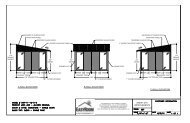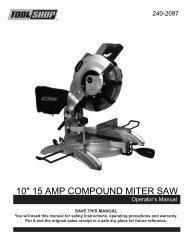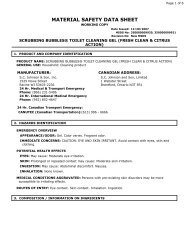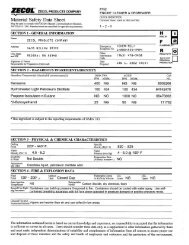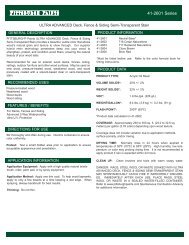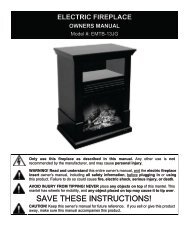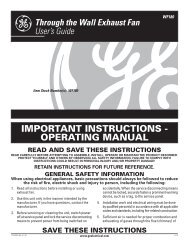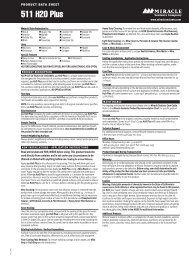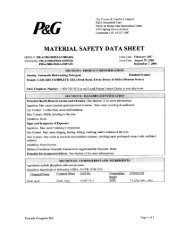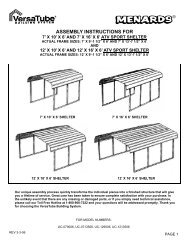MSDS No: 050115 Issue Date: 29 April 2009 Page: 1 of 5 ... - Menards
MSDS No: 050115 Issue Date: 29 April 2009 Page: 1 of 5 ... - Menards
MSDS No: 050115 Issue Date: 29 April 2009 Page: 1 of 5 ... - Menards
You also want an ePaper? Increase the reach of your titles
YUMPU automatically turns print PDFs into web optimized ePapers that Google loves.
MATERIAL SAFETY DATA SHEET<br />
SECTION 1 PRODUCT AND COMPANY IDENTIFICATION<br />
Trade Name: Faucet & Valve Grease<br />
<strong>MSDS</strong> <strong>No</strong>: <strong>050115</strong><br />
<strong>Issue</strong> <strong>Date</strong>: <strong>29</strong> <strong>April</strong> <strong>2009</strong><br />
<strong>Page</strong>: 1 <strong>of</strong> 5<br />
Part <strong>No</strong>s. 050005-30 050035-12 050051 050120 20-4047 PLGREASE<br />
Covered by 050007 050035-48 050055-12 050125 2WY65 PV060116<br />
this <strong>MSDS</strong>: 050010-48 050050-12 050055-48 050126 403683 S95-709<br />
050020 050050-48 050060-48 050190 440945<br />
050025 050050-C <strong>050115</strong> 050200 45090<br />
050030 050050-D 050116 11-1024 461253<br />
Product Use: General purpose lubrication.<br />
Formula: See Section 2.<br />
Synonyms: All Purpose Grease, Lithium Grease #2<br />
Firm Name & William H. Harvey Company 4334 South 67 th Street<br />
Mailing Address: Omaha, Nebraska 68117, U.S.A. http://www.wmharvey.com<br />
Pone Number: (402) 331-1175 or (800) 228-9681<br />
Emergency Phone For Emergency First Aid call Toll Free 1-877-740-5015 For<br />
Numbers: chemical transportation emergencies ONLY, call Chemtrec at<br />
1-800-424-9300. Outside the U.S. 1-703-527-3887.<br />
Prepared By: Technical Department<br />
Preparation <strong>Date</strong>: <strong>April</strong> <strong>29</strong>, <strong>2009</strong><br />
SECTION 2 COMPOSITION/INFORMATION ON INGREDIENTS<br />
INGREDIENTS: %wt/wt: CAS NUMBER: ACGIH TLV TWA: ACGIH STEL: OSHA PEL TWA:<br />
Mineral Oil
<strong>MSDS</strong> <strong>No</strong>: <strong>050115</strong><br />
<strong>Issue</strong> <strong>Date</strong>: <strong>29</strong> <strong>April</strong> <strong>2009</strong><br />
<strong>Page</strong>: 2 <strong>of</strong> 5<br />
SECTION 4 FIRST AID MEASURES<br />
FOR EMERGENCY FIRST AID HELP CALL TOLL FREE 1-877-740-5015<br />
EYE CONTACT: Hold eyelids open and flush with a steady, gentle stream <strong>of</strong> water<br />
for at least 15 minutes.<br />
SKIN CONTACT: Remove product from the skin by washing with a mild soap and<br />
water. Contaminated clothing should be removed to prevent<br />
prolonged exposure. If product is injected under the skin, seek<br />
medical treatment immediately. If symptoms <strong>of</strong> exposure persist,<br />
contact a physician.<br />
INHALATION: If signs or symptoms <strong>of</strong> overexposure occur, remove the person to<br />
fresh air. If symptoms persist, seek medical attention.<br />
INGESTION: If ingested, dilute stomach contents with two glasses <strong>of</strong> milk or<br />
water.<br />
<strong>No</strong>te: Do <strong>No</strong>t give anything by mouth to an unconscious person.<br />
Do not induce vomiting without medical supervision. If vomiting<br />
occurs spontaneously, keep airway clear. If symptoms <strong>of</strong><br />
ingestion persist, seek medical attention.<br />
NOTE TO PHYSICIAN:<br />
<strong>No</strong> further data known.<br />
SECTION 5 FIRE FIGHTING MEASURES<br />
Flashpoint/Method: 340 Deg. F / COC<br />
Flammability: LEL = <strong>No</strong>t Applicable, UEL = <strong>No</strong>t Applicable.<br />
Extinguishing In accordance with NFPA guidance, dry chemical, foam, or<br />
Media: CO2 fire extinguishers are all acceptable. <strong>No</strong>te that while<br />
water fog extinguishers are also acceptable, do NOT apply a<br />
direct stream <strong>of</strong> water onto burning product because it may<br />
cause spreading and increase fire intensity.<br />
Special Fire Firefighters should wear positive pressure self-contained<br />
Fighting breathing apparatus and full protective clothing for fires<br />
Procedure: areas where chemicals are used or stored.<br />
Unusual Fire<br />
And Explosion<br />
Hazards: <strong>No</strong>ne<br />
Hazardous<br />
Decomposition<br />
Products: <strong>No</strong>ne<br />
SECTION 6 ACCIDENTAL RELEASE MEASURES<br />
Clean-Up Measures: As with any spill or leak, before responding ensure that<br />
you are familiar with the potential hazards and<br />
recommendations <strong>of</strong> the <strong>MSDS</strong>. Appropriate Personal<br />
Protective Equipment (PPE) must be worn. See Section 8 <strong>of</strong><br />
this <strong>MSDS</strong> for PPE recommendations.<br />
If possible, safely contain the spill with dikes or othe<br />
spill response equipment appropriate for petroleum or<br />
organic material releases. Take measures to prevent<br />
spreading <strong>of</strong> product. <strong>No</strong>te that while product will ignite<br />
it will not readily burn. However, as a precaution<br />
eliminate ignition sources. Prevent from entering sewers or<br />
waterways. Large volumes may be transferred to an<br />
appropriate container for proper disposal. Small volumes or<br />
residues may be soaked up with absorbents. Spill response<br />
materials should be collected for proper disposal.
<strong>MSDS</strong> <strong>No</strong>: <strong>050115</strong><br />
<strong>Issue</strong> <strong>Date</strong>: <strong>29</strong> <strong>April</strong> <strong>2009</strong><br />
<strong>Page</strong>: 3 <strong>of</strong> 5<br />
SECTION 7 HANDLING AND STORAGE<br />
Handling: As with any industrial chemical, handle the product in a manner<br />
that minimizes exposure to practicable levels. Prior to handling,<br />
consult Section 8 <strong>of</strong> this <strong>MSDS</strong> to evaluate Personal Protective<br />
Equipment needs. Open containers slowly to relieve any pressure.<br />
Follow all other standard industrial hygiene practices.<br />
Empty containers may contain product residue. All safety<br />
precautions taken when handling this product should also be taken<br />
when handling empty drums and containers. Keep containers closed<br />
when not in use.<br />
Product residue in empty containers is combustible but will not<br />
readily burn. <strong>No</strong>te however, that excessive heating or citting <strong>of</strong><br />
empty containers may create an ignition source sufficient to start<br />
a fire and in extreme cases, cause an explosion.<br />
Storage: Protect product quality by storing indoors and away for extreme<br />
temperatures. Close all containers when not it use.<br />
SECTION 8 EXPOSURE CONTROLS/PERSONAL PROTECTION<br />
Personal Selection <strong>of</strong> Personal Protective Equipment should be based upon<br />
Protective the anticipated exposure and made in accordance with OSHA’s<br />
Equipment: Personal Protective Equipment Standard found in <strong>29</strong> CFR 1910<br />
Subpart I. The following information may be used to assist in PPE<br />
selection.<br />
Eye Wear eye protection appropriate to prevent eye exposure. Where<br />
Protection: splashing is not likely, chemical safety glasses with side shields<br />
are recommended. Where splashing may occur, chemical goggles or<br />
full face shield is recommended.<br />
Skin Gloves are not normally needed during normal conditions <strong>of</strong> use. If<br />
Protection: health effects are experienced , oil or chemical resistant gloves<br />
such as butyl or nitrile are recommended.<br />
Where splashing or soaking is likely, wear oil or chemical<br />
resistant clothing to prevent exposure.<br />
Respiratory A respirator may be worn to reduce exposure to vapors, dust, or<br />
Protection: mist. Select a NIOSH/MSHA approved respirator appropriate for the<br />
type and physical character <strong>of</strong> the airborne material. A selfcontained<br />
breathing apparatus is recommended in all situations<br />
where airborne contaminant concentration has not been confirmed to<br />
be below safe levels. Respirator use should comply with the OSHA<br />
Respirator Protection Standard found in <strong>29</strong> CFR 1910.134.<br />
Engineering <strong>No</strong>rmal general ventilation is expected to be adequate. It is<br />
Controls: recommended that ventilation be designed in all instances to<br />
maintain airborne concentrations at lowest practicable levels.<br />
Ventilation should at a minimum, prevent airborne concentrations<br />
from exceeding any exposure limits listed in Section 2 <strong>of</strong> this<br />
<strong>MSDS</strong>.<br />
The user may wish to refer to <strong>29</strong> CFR 1910.1000(d) (2) and the<br />
ACGIH “Threshold Limit Values for Chemical Substances and Physical<br />
Agents Biological Exposure Indicies” (Appendix C) for the<br />
determination <strong>of</strong> exposure limits <strong>of</strong> mixtures. An industrial<br />
hygienist or similar pr<strong>of</strong>essional may be consulted to confirm that<br />
the calculated exposure limits apply.
SECTION 9 PHYSICAL AND CHEMICAL PROPERTIES<br />
Physical Appearance: Amber colored grease<br />
Odor: Mild Petroleum<br />
Physical State: Semi-solid<br />
Water Solubility: Insoluble<br />
Specific Gravity: .917<br />
<strong>MSDS</strong> <strong>No</strong>: <strong>050115</strong><br />
<strong>Issue</strong> <strong>Date</strong>: <strong>29</strong> <strong>April</strong> <strong>2009</strong><br />
<strong>Page</strong>: 4 <strong>of</strong> 5<br />
SECTION 10 STABILITY AND REACTIVITY<br />
Stability: Stable.<br />
Conditions To Avoid: Avoid contact with incompatible materials and exposure to<br />
extreme temperatures.<br />
Hazardous Thermal decomposition products are dependent on combustion<br />
Decomposition conditions. A complex mixture <strong>of</strong> airborne solid, liquid,<br />
Products: particulates and gases may evolve when the material burns.<br />
Combustion byproducts may include oxides <strong>of</strong> carbon, burned<br />
Hydrocarbons as fumes and smoke.<br />
Incompatibility/<br />
Materials To Avoid: Strong oxidizing agents.<br />
Hazardous<br />
Polymerization: This product is not expected to polymerize.<br />
SECTION 11 TOXICOLOGICAL INFORMATION<br />
Inhalation: <strong>No</strong> toxicological data known.<br />
Skin: <strong>No</strong> toxicological data known.<br />
Eye: <strong>No</strong> toxicological data known.<br />
Ingestion: <strong>No</strong> toxicological data known.<br />
Other: <strong>No</strong> further data known.<br />
SECTION 12 ECOLOGICAL INFORMATION<br />
Ecotoxicological This product has not been evaluated for ecotoxicity. As with<br />
information: any industrial chemical, exposure to the environment should be<br />
prevented and minimized wherever possible.<br />
Environmental The degree <strong>of</strong> biodegradability and persistence <strong>of</strong> this product<br />
Fate: has not been determined.<br />
VOC This product emits VOC's (volatile organic compounds)in its<br />
Information use. Make sure that use <strong>of</strong> this product complies with local<br />
VOC emission regulations, where they exist.<br />
VOC Content: 15.6 grams/liter (1.7% by wt.)as produced.<br />
SECTION 13 DISPOSAL CONSIDERATIONS<br />
Waste Disposal: Ensure that collection, transport, treatment, and disposal <strong>of</strong><br />
waste product, containers and rinsate complies with all<br />
applicable laws and regulations. <strong>No</strong>te that use, mixture,<br />
processing, or contamination <strong>of</strong> the product may cause the<br />
material to be classified as a hazardous waste.<br />
It is the responsibility <strong>of</strong> the product user or owner to<br />
determine at the time <strong>of</strong> disposal, whether the product is<br />
regulated as a hazardous waste.
<strong>MSDS</strong> <strong>No</strong>: <strong>050115</strong><br />
<strong>Issue</strong> <strong>Date</strong>: <strong>29</strong> <strong>April</strong> <strong>2009</strong><br />
<strong>Page</strong>: 5 <strong>of</strong> 5<br />
SECTION 14 TRANSPORT INFORMATION<br />
DOT<br />
Proper Shipping Name: <strong>No</strong>t hazardous under DOT transportation.<br />
Hazard Class/Packing Group: <strong>No</strong>t applicable<br />
UN/NA Number: <strong>No</strong>t applicable<br />
Hazard Labels: <strong>No</strong>t applicable<br />
IMDG<br />
Proper Shipping Name: <strong>No</strong>t applicable<br />
Hazard Class/Packing Group: <strong>No</strong>t applicable<br />
UN Number: <strong>No</strong>t applicable<br />
Label: <strong>No</strong>t applicable<br />
SECTION 15 REGULATORY INFORMATION<br />
Hazard Category for<br />
Section 311/312:<br />
Section 302 Extremely<br />
Hazardous Substances<br />
(TPQ):<br />
Section 313 Toxic<br />
Chemicals:<br />
CERCLA 103 Reportable<br />
Quantity:<br />
TSCA Inventory:<br />
State Regulations:<br />
SECTION 16 OTHER INFORMATION<br />
This product contains mineral oil and is subject<br />
to regulation by Section 311 <strong>of</strong> the Clean Water<br />
Act and the oil Pollution Act. Releases <strong>of</strong> the<br />
product into or leading to surface waters must be<br />
reported to the National Response Center at 1-800-<br />
424-8802.<br />
This product does not contain chemicals regulated<br />
under SARA Title III, Section 302.<br />
This product contains NONE <strong>of</strong> the substances<br />
subject to the reporting requirements <strong>of</strong> Section<br />
313 <strong>of</strong> Title III <strong>of</strong> the Superfund Amendments and<br />
Reauthorization Act <strong>of</strong> 1986 and 40 CFR Part 372.<br />
This product does not contain chemicals regulated<br />
under CERCLA.<br />
Many states have more stringent release reporting<br />
requirements. Report spills required under federal,<br />
state and local regulations.<br />
All <strong>of</strong> the components <strong>of</strong> this product are listed on<br />
the TSCA inventory.<br />
This product contains mineral oil, and as used, may<br />
be regulated by state used oil regulations. Check<br />
with the appropriate state agency to determine<br />
whether such a regulation exists.<br />
NFPA and HMIS:<br />
NFPA Hazard Signal: Health: 1 Flammability: 1 Reactivity: 0 Special: <strong>No</strong>ne<br />
HMIS Hazard Signal: Health: 1 Flammability: 1 Reactivity: 0 PPE: B<br />
Disclaimer:<br />
The information herein has been compiled from sources believed to be reliable,<br />
up-to-date, and is accurate to the best <strong>of</strong> our knowledge. However, William H.<br />
Harvey Company cannot give any guarantees regarding information from other<br />
sources, and expressly does not make warranties, nor assumes any liability for<br />
its use.



